Hyacinth flower which is scientifically called Hyacinthus orientalis, is a fragrant and vibrant spring-flowering bulbous plant that belongs to the Asparagaceae family. Known for its distinctive spike of tightly clustered, bell-shaped flowers and sweet fragrance, the hyacinth is a popular choice in gardens, borders, and containers.

Hyacinthus orientalis is a perennial plant that grows from a bulb. Hyacinth plants grow from bulbs, and their growth habit is upright and compact. The bulbs give rise to linear, strap-shaped leaves that emerge from the base of the plant. The leaves of the hyacinth are glossy and have a slightly succulent texture. They are arranged in a rosette at the base of the plant and can reach a length of 6 to 12 inches (15 to 30 cm).
One of the distinctive features of the hyacinth is its central flower spike. The spike, known as a raceme, stands erect and bears numerous closely packed, tubular flowers. The individual flowers of the hyacinth are bell-shaped, with a characteristic tubular structure. They have six petals and come in a wide range of colors, including shades of blue, purple, pink, white, and yellow.
One of the most distinctive features of hyacinths is their strong, sweet fragrance. The scent is often described as rich and delightful, making hyacinths a popular choice for both outdoor gardens and indoor arrangements.
The hyacinth has cultural significance in various traditions and is associated with different meanings. In the language of flowers, hyacinths symbolize beauty, love, and sincerity. In Greek mythology, the flower is linked to the story of Hyacinthus, a youth loved by the god Apollo.

Cultivars of Hyacinth
There are numerous cultivars of the Hyacinth (Hyacinthus orientalis), each offering distinct features in terms of flower color, form, and fragrance. Here are some popular cultivars of Hyacinth:
‘Blue Jacket’: A deep blue-flowered cultivar with a strong, sweet fragrance. ‘Blue Jacket’ is known for its rich color and compact flower spikes.

‘Delft Blue’: This cultivar features soft, porcelain blue flowers. ‘Delft Blue’ is a classic variety with a delightful fragrance and is commonly used for forcing indoors.
‘Carnegie’: ‘Carnegie’ is a white-flowered cultivar known for its pure and clean appearance. The flowers are highly fragrant, making it an excellent choice for both gardens and cut flower arrangements.
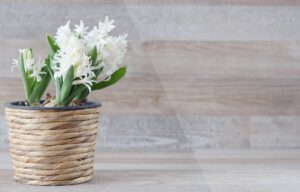
‘Jan Bos’: A distinctive cultivar with bright, reddish-pink flowers and a powerful fragrance. ‘Jan Bos’ is often chosen for its bold and eye-catching color.
‘Gypsy Queen’: ‘Gypsy Queen’ is characterized by its apricot-pink flowers with a yellowish tint. The blooms are fragrant and add a warm and unique hue to spring gardens.

‘City of Haarlem’: This cultivar displays soft, buttery yellow flowers and a sweet fragrance. ‘City of Haarlem’ is a charming variety that adds a touch of warmth to the garden.
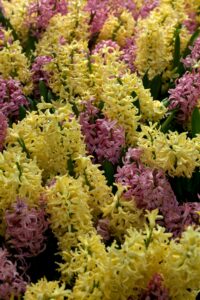
‘Pink Pearl’: ‘Pink Pearl’ features delicate, light pink flowers and a pleasing fragrance. It is an elegant cultivar that complements various color schemes in garden designs.

‘Woodstock’: Known for its deep, wine-red flowers, ‘Woodstock’ is a striking cultivar that adds a bold and dramatic element to the garden. The fragrance is intense and captivating.
‘Fondant’: ‘Fondant’ is a pastel-hued cultivar with soft pink flowers. It adds a touch of sweetness to garden borders and is a favorite for its gentle coloration.
‘Peter Stuyvesant’: This cultivar features violet-blue flowers and a strong fragrance. ‘Peter Stuyvesant’ is known for its vivid color and is often chosen for both outdoor planting and indoor forcing.

‘Miss Saigon’: ‘Miss Saigon’ is a bicolor cultivar with lavender-pink flowers and a white edge. The contrasting colors create an attractive and eye-catching display in gardens.

‘Festival’: ‘Festival’ is a mix of various colored hyacinths, creating a vibrant and multicolored display. This mix is often used for creating dynamic and diverse garden arrangements.
These cultivars showcase the diversity of Hyacinth flowers, providing options for various color preferences and garden designs. When selecting cultivars, consider factors such as flower color, fragrance intensity, and overall garden aesthetics.
Sunlight Requirement
Hyacinth flowers prefer locations with full sun to partial shade. Plant them in areas where they receive at least 6 hours of direct sunlight per day for optimal growth and flowering. While hyacinths can tolerate partial shade, they bloom most abundantly when exposed to plenty of sunlight. A site with morning sunlight and some protection from intense afternoon sun is often ideal. Insufficient sunlight can lead to stretched, leggy growth and reduced flowering.

If you are forcing hyacinth bulbs indoors for early bloom, provide them with bright, indirect light. Placing indoor containers near a sunny window is beneficial. Once the flowers begin to bloom, you can move them to a more prominent location. If growing hyacinths in containers, place the containers in a sunny spot on patios, decks, or balconies. Ensure that the containers have drainage holes to prevent waterlogging.
Temperature and Humidity Requirements for Hyacinth Flowers
Hyacinth flowers are cold-season bulbs that thrive in cooler temperatures. They are well-suited for planting in the fall and blooming in the early spring. The ideal temperature range for growing hyacinths is around 50°F to 60°F (10°C to 15°C). Hyacinths are relatively cold-tolerant and can withstand frost. Exposure to cooler temperatures during the growing season contributes to the development of sturdy flower stems and vibrant blooms. Hyacinth bulbs require a chilling period to break dormancy and promote flowering. This chilling period typically involves exposure to temperatures between 35°F to 45°F (1.5°C to 7.2°C) for an extended duration, usually around 10 to 12 weeks. This can be achieved by planting bulbs in the fall.
For indoor forcing, where hyacinth bulbs are grown in containers for early bloom, a chilling period is still essential. This is often simulated by pre-chilling the bulbs in a refrigerator before bringing them into a warmer environment for forcing. Once the chilling requirement is met, the bulbs can be forced at temperatures between 60°F to 65°F (15°C to 18°C).
While hyacinths prefer cooler temperatures, they can tolerate mild spring warmth. However, they may not perform well in regions with prolonged periods of extreme heat. In warmer climates, plant them in locations where they receive morning sunlight and some protection from intense afternoon sun.
Hyacinth flowers are adaptable to a range of humidity levels. They can tolerate typical humidity levels found in gardens and landscapes. Indoor forcing usually provides sufficient humidity for hyacinths, and additional measures are not typically required.

Soil Requirement of Hyacinth Flower
Hyacinths prefer well-draining soil to prevent waterlogged conditions, which can lead to bulb rot. Amend heavy or clayey soils by incorporating organic matter such as compost or well-rotted manure to improve drainage. The ideal soil pH for hyacinths is slightly acidic to neutral, ranging between 6.0 and 7.0. Soil pH outside this range may affect nutrient availability to the plants.
Loose and aerated soil promotes healthy root development and prevents compaction. Cultivate the soil to a depth of 8 to 12 inches (20 to 30 cm) before planting hyacinth bulbs. Enrich the soil with organic matter to improve fertility and texture. Plant hyacinth bulbs at a depth of approximately 4 to 6 inches (10 to 15 cm) in well-prepared soil. The planting depth helps protect the bulbs from temperature extremes and supports strong root development.

If growing hyacinths in containers, use a well-draining potting mix designed for bulbs or general container gardening. Make sure the containers have drainage holes to prevent water accumulation.
Propagation of Hyacinth Flower
Hyacinth flowers are commonly propagated through bulbs. This process involves separating and replanting the bulb offsets or bulblets produced by the mother bulb. Here’s a guide on how to propagate hyacinth flowers:

Allow the hyacinth bulbs to complete their growing cycle, including flowering and foliage die-back. Bulblets typically form around the base of the mother bulb during this period.
Carefully lift the hyacinth bulbs from the soil using a garden fork or shovel. Be cautious not to damage the bulbs during the lifting process.
Gently separate the bulblets from the main bulb. Each bulblet should have its roots attached. The bulblets are the smaller, undeveloped bulbs that can be found clustered around the base of the main bulb.
Inspect the bulblets for any signs of damage or disease. Trim off any damaged or unhealthy parts.
Plant the separated bulblets at the desired location or in containers. Follow the recommended planting depth, usually around 4 to 6 inches (10 to 15 cm), and ensure good soil drainage.
Water the newly planted bulblets thoroughly to settle the soil around the roots. Maintain consistent moisture, especially during the growing season.
Provide the propagated hyacinth bulbs with the same care as established plants. They will establish roots and grow into mature plants over time.

Water Requirements of Hyacinth Flower
Hyacinths require consistently moist soil throughout their growth stages, from planting to post-flowering. Adequate moisture is vital for healthy foliage and flower development. Water regularly, adjusting frequency based on local climate and soil type. Maintain soil moisture without waterlogging, ensuring deep watering to promote robust root systems, as shallow watering may weaken roots and increase drought susceptibility.
After planting hyacinth bulbs, water the soil thoroughly to settle it around the bulbs and promote root establishment. Once hyacinths have finished flowering and entered the dormancy phase, reduce the frequency of watering. Allow the foliage to yellow and wither naturally. During dormancy, the bulbs are less active, and excessive moisture can lead to bulb rot. Hyacinths are susceptible to bulb rot in waterlogged or poorly drained soil. Ensure that the planting site has good drainage to prevent excess water around the bulbs. Raised beds or well-amended soil can help improve drainage.
If growing hyacinths in containers, monitor the moisture level closely, as containers may dry out more quickly than garden beds. Water the containers when the top inch of soil feels dry to the touch.
Fertilizer Requirement
Hyacinth flowers benefit from proper fertilization to support their growth, flowering, and overall health. Before planting hyacinth bulbs, incorporate well-rotted compost or aged manure into the soil. This provides organic matter and essential nutrients to support initial growth. When planting hyacinth bulbs, mix a balanced, granular fertilizer into the soil. A general-purpose fertilizer with equal or balanced N-P-K (nitrogen-phosphorus-potassium) ratios is suitable.
After hyacinths have finished flowering, they enter a period of dormancy. During this time, reduce or cease fertilizer application. The bulbs are less active, and excessive nutrients may lead to soft growth that is more susceptible to diseases.
Hyacinths generally do not require high levels of nitrogen, especially after flowering. High-nitrogen fertilizers can promote excessive foliage growth at the expense of flower development. Choose a fertilizer with a balanced nutrient content, such as a 10-10-10 or 5-10-10 formulation.

Deadheading Hyacinth Flower
Deadheading hyacinth flowers involves the removal of spent or faded blooms to promote a neater appearance and redirect the plant’s energy. Begin deadheading hyacinths as soon as the flowers start to fade and lose their vibrant color. This practice is typically done after the peak of flowering.
Pinch or cut off the individual faded flowers using your fingers or gardening shears. Ensure you remove the entire spent flower head, including the stem. Deadheading prevents the plant from investing energy in seed formation. Redirecting this energy back into the bulb encourages stronger growth and potential for better blooms in the following year.
Problems While Growing Hyacinth Flower
While hyacinths are generally hardy and easy to grow, they may face certain problems that can affect their health and blooming. Here are some common issues and solutions when growing hyacinth flowers:
Bulb Rot: Excessive moisture or poor drainage can lead to bulb rot. Plant hyacinth bulbs in well-draining soil and avoid overwatering. Ensure proper soil drainage to prevent waterlogging.
Pests: Common pests like slugs, snails, and rodents may damage hyacinth bulbs and foliage. Use protective measures, like planting bulbs in wire mesh cages, to deter rodents. Inspect bulbs for signs of pests before planting.
Fungal Diseases: Wet conditions or poor air circulation can lead to fungal diseases, including gray mold (Botrytis) and basal rot. Plant bulbs in well-draining soil, provide proper spacing and ensure good air circulation. Remove and dispose of infected plant material.
Failure to Bloom: Factors such as insufficient chilling period, poor soil fertility, or planting bulbs too shallow may result in a lack of blooms. Ensure bulbs receive an adequate chilling period before planting. Plant at the recommended depth in well-fertilized soil.
Stretched or Leggy Growth: Insufficient light can lead to elongated, weak stems. Ensure hyacinths receive adequate sunlight. If grown indoors, place them in a bright location. Outdoors, choose a site with full to partial sunlight.
Drooping Flower Heads: Hyacinth flowers may droop if they are top-heavy or if the weather is excessively wet. Provide support for tall varieties to prevent bending. Allow the flowers to dry if wet, as waterlogged conditions can contribute to drooping.
Late Frost Damage: Late spring frosts can damage emerging shoots and flower buds. Cover plants with a cloth or other protective material during late frosts to prevent damage. Plant bulbs in locations less prone to late frosts.
Regularly monitoring your hyacinth plants, providing proper care, and addressing issues promptly will help ensure their health and vibrant blooms.
Ornamental Uses of Hyacinth Flower
Hyacinth flowers are valued for their ornamental beauty and are commonly used in various landscaping and decorative arrangements. Here are some ornamental uses of hyacinth flowers:
Garden Borders and Beds: Hyacinths add vibrant splashes of color to garden borders and beds. Planting them in clusters or rows enhances the visual impact and creates a stunning spring display.
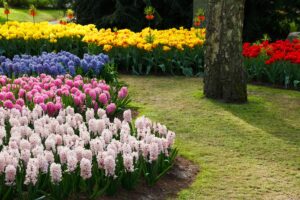
Container Gardens: Hyacinths are well-suited for container gardening. Planted in pots or containers, they can be placed on patios, balconies, or near entrances, providing a burst of color and fragrance.

Spring Bulb Displays: Hyacinths are often featured in spring bulb displays alongside other early-blooming bulbs like tulips and daffodils. These displays create a dynamic and visually appealing landscape.
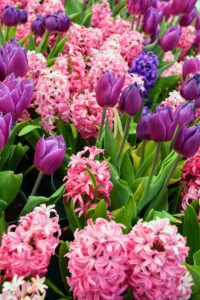
Cut Flower Arrangements: Hyacinth flowers are popular choices for cut flower arrangements due to their vibrant colors and sweet fragrance. They add charm to floral bouquets and centerpieces.

Indoor Forcing: Hyacinth bulbs can be forced indoors during winter to produce early blooms. Planted in pots or forcing glasses, they bring a touch of spring to indoor spaces, emitting a delightful fragrance.

Fragrance Gardens: The intense and pleasant fragrance of hyacinth flowers makes them valuable additions to fragrance gardens. Planting them near seating areas or along pathways allows people to enjoy their scent.
Rock Gardens: The compact size and colorful blooms of hyacinths make them suitable for rock gardens. Their vertical spikes contrast with the surrounding rocks, adding interest to the landscape.
Symbolic Gardens: Hyacinths have symbolic meanings associated with rebirth and the coming of spring. They can be used in themed gardens or planted in specific patterns to convey symbolic messages.
Wedding Decor: Hyacinth flowers are chosen for wedding decor, bouquets, and floral arrangements. Their elegance, range of colors, and sweet fragrance make them popular choices for weddings.
Event Decorations: Hyacinths are used in event decorations, including table centerpieces and venue arrangements. Their vibrant hues contribute to the overall aesthetic of spring-themed events.
Pollinator Gardens: While not the primary attractant for pollinators, hyacinths may attract some early-season pollinators like bees. Including them in pollinator-friendly gardens adds to the diversity of floral resources.
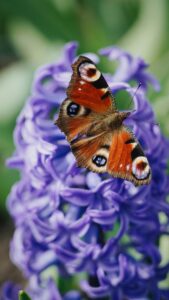
Hyacinths are versatile ornamental plants that can be creatively integrated into various outdoor and indoor settings, providing both visual appeal and delightful fragrances.


